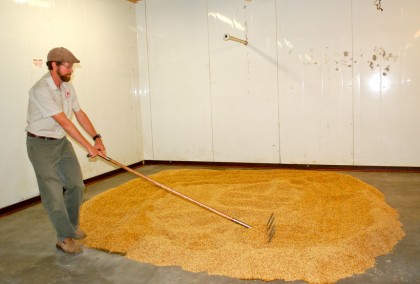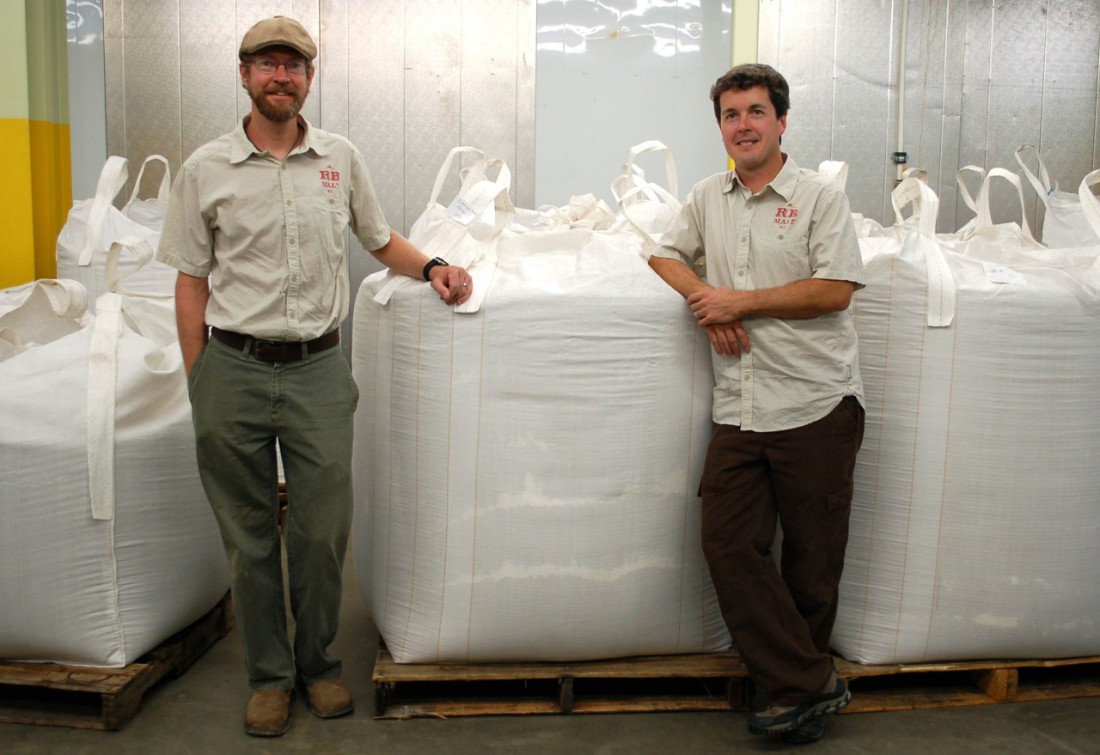Brent Manning and Brian Simpson want to take drinking local to a whole other level with their new malt house in West Asheville.
Think about it. You may support local breweries by quaffing their beers, but some ingredients — i.e., the malts — typically are grown and processed 3,000 miles away, then shipped here.
Manning and Simpson are striving to change that with the Riverbend Malt House.
The business partners met in Wilmington where they both worked as environmental consultants. Almost two years ago, they set out to ascertain why none of the barley grown in North Carolina is used to make North Carolina beer. Until now, most of that grain has gone to feed livestock.
Now farmers Buddy and Chris Hoffner of Salisbury, N.C., are growing barley and one type of wheat for Riverbend. Manning and Simpson received their first 40 tons of Hoffner barley last week, and after months of permit wrangling, they’re now malting grain in West Asheville.
Let’s take it back a step for the non-brewers. Malt is one of the primary ingredients in beer. It’s basically a grain, typically barley, wheat or rye, that’s been germinated then dried in a kiln (it isn’t the same as hops — that’s a different plant entirely). The process of malting develops the enzymes necessary to turn the grain’s starches into sugars. Malted grains are used to make beer, whiskey, malt vinegar and the malted milk balls that most of us only eat in movie theaters.
Riverbend will produce malts for brewing, though Manning notes that they could create distilling malt if folks want them to do so.
While the business’ start-up pile of 40 tons of barley may seem like a lot, Manning put it into perspective for me. Each ton of malted grain typically supplies one run of beer through a 30-barrel brewing system. Highland Brewing Company uses 6 to 8 tons of grain weekly, he says.
Thus, Riverbend is starting small for a lot of reasons (they call themselves a micro-malt house), but primarily because the owners want to produce the best malt possible before they wholesale it.
Manning notes that lots of regional brewers (and one in Florida) have expressed interest in buying their malt, but the Riverbend guys haven’t been ready to commit. They’re still running test batches and using those to make home brews. And those brews are getting rave reviews — the Riverbend Appalachian Pale Ale was chosen as a winner at the Just Brew It Home Brew Festival in Asheville last spring. The beer was produced using 85 percent locally grown and malted barley and hops, including hops grown at Echoview Farms in Weaverville. Green Man Brewing will brew up a batch of this beer later this year.
But Manning and Simpson aren’t brewing at Riverbend; they’re malting. And they believe they’re the only malt house in the Southeast — and one of only a handful on the East Coast.
In most large malt-production businesses (located primarily in the western U.S., Canada and the U.K.), the process is mostly automated. But Manning and Simpson are using the traditional 250-year-old Scottish method of floor malting.
The Maltsters share a large warehouse with a few other businesses on Brevard Road. The space works because they can germinate the grains in what formerly was the banana-storage room of a produce distribution business. As such, it contains floor drains and is climate-controlled — both necessary for grain germination.
Here’s how the seven-day malting process goes. Once the grain has gone through a few wet/dry steep cycles in holding tanks to jumpstart germination, it’s spread on the clean concrete floor of the banana room. Then the grains must be raked apart so they don’t grow together into an unusable mat. The hand-raking (floor malting) must take place about every four hours for three days until the grains are ready for the kiln. The rake that the Riverbend guys use was made for them by Steebo Design based on an old picture (see below).

“We’ll practically be sleeping on our grain. We’ll treat every batch like a baby,” Manning notes.
Next, the grains go into the kiln for the drying and roasting parts of the process. Manning and Simpson built their kiln from insulated panels that once lined the walls of a Winn Dixie butcher shop. Different grains take different times and temperatures to develop, but kilning typically takes 30 to 36 hours. Then the malt runs through a de-bearder to remove the roots and polish them (methinks Asheville’s male population could use a de-bearder every once in a while). Finally, the grains are cleaned (again) in a seed cleaner and bagged in 50-pound or 1-ton bags.
Manning and Simpson plan to produce distinctive-flavored malts that will be identifiable to the region in which the grains are grown.
“A malt house is kind of like a winery,” Simpson says. “Grapes from each winery are distinct to those soils. It’s the same with grains. Different soils and climates produce different flavors.”
The circle of farmer, malter and brewer can now all be contained within a few hundred miles (in addition to Salisbury, Manning has sourced rye from a farm in Polk County and a hard red wheat from Eastern N.C.). In just a few weeks, Riverbend Malt House will be able to sell their regionally grown sustainable boutique malts to brewers. Then you and I can drink it.






This is a beautiful thing! I see a living wage certified beer in the near future!
Brewing pays living wages in this town.
Thanks for the info on the production process. I can see good results in the future. The floor malting process is new to me. Looks like your research will pay off. Uncle James
Not the first OR only barley malters in the area… Check out Farmboy Brewery in Chatham Co. NC!!! Not that anyone’s counting.